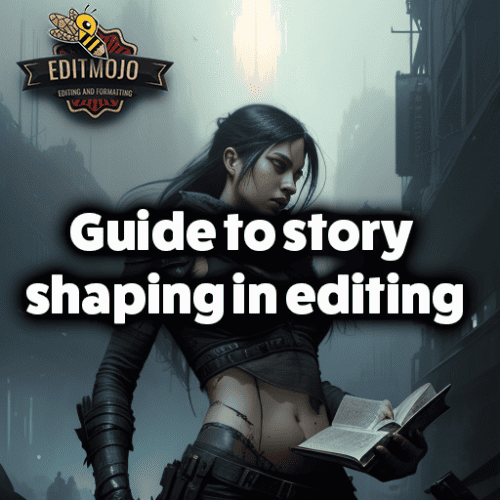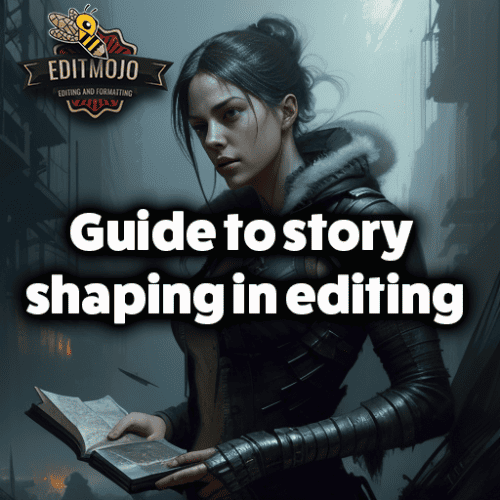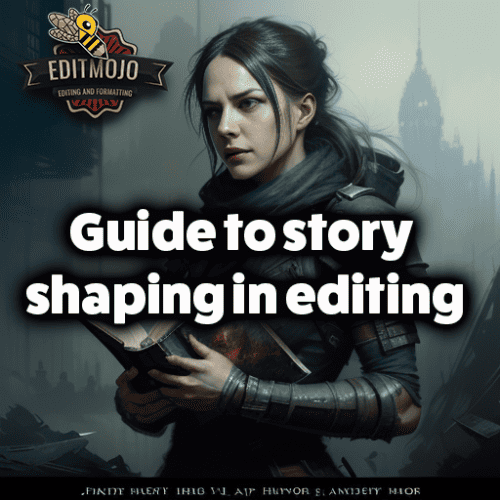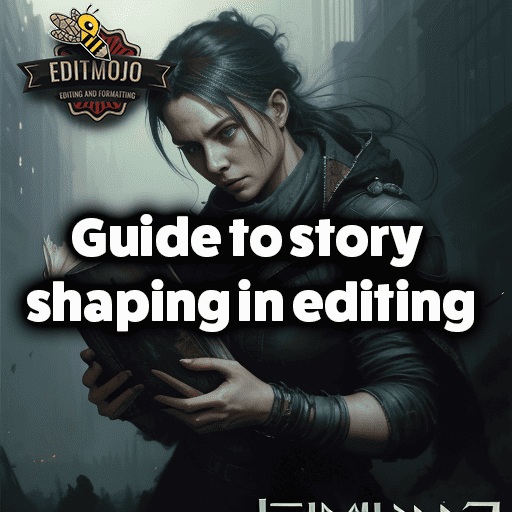Guide to story shaping in editing
Guide to story shaping in editing. In the grand scheme of storytelling, editing is like a chisel on a sculptor’s workbench. It’s the process that shapes a raw narrative, hones the plot, refines characters, and polishes the language. The art of story shaping is an integral part of this editing process. An adept story shaper can transform a good story into an unforgettable one that resonates with readers long after they’ve turned the last page.
Key Takeaway Table
| Section | Key Takeaway |
|---|---|
| Understanding Story Shaping | Story shaping is an editing process that focuses on enhancing the overall narrative beyond mere grammar correction. It involves refining plot structure, character arcs, pacing, and world building. |
| Core Elements of Story Shaping | Plot development, character development, setting, and pacing are crucial to story shaping. Editors must ensure these elements are coherent, consistent, and compelling. |
| Process of Story Shaping | The process involves an initial read-through, structural editing, line editing, and finally, copy editing and proofreading. Each stage contributes uniquely to the story shaping process. |
| Role of Feedback | Feedback provides fresh perspectives and can reveal blind spots. However, it should be used judiciously, keeping the story’s vision in mind. |
| Common Mistakes | Common mistakes include overcomplicated plot, underdeveloped characters, inconsistent pacing, and inadequate world building. Editors should strive to avoid these. |
| Digital Tools in Story Shaping | Digital tools like Grammarly, ProWritingAid, and AutoCrit can aid in the story shaping process, from checking grammar to analyzing pacing and repetitiveness. |
Understanding the Concept of Story Shaping
Unlike traditional editing, which mostly focuses on fixing grammatical errors, inconsistencies, and narrative clarity, story shaping takes a deep dive into the story’s structure, character arcs, plot development, and pacing. It’s about stepping back, assessing the big picture, and finding ways to enhance the narrative’s overall impact.
Editors don a multitude of hats in this process. They are collaborators, allies, and sometimes the first audience to the writer’s work. Their role is to identify and resolve weaknesses that the writer might have overlooked and refine elements that need more emphasis.
Core Elements of Story Shaping
Plot Development
The plot is the backbone of any story. A well-constructed plot can sweep readers off their feet and lead them through a flurry of emotions. Identifying weak points in the plot during editing is crucial. A sudden, unexplained turn of events or a plot that’s too predictable can turn readers away.

Techniques to strengthen the plot include adding foreshadowing, plot twists, or surprise elements. Sometimes, even reshuffling the events can make a difference. For instance, beginning in medias res, or in the middle of the action, can draw readers into the story immediately.
Character Development
A story’s soul lies within its characters. Characters drive the plot forward, pull at readers’ heartstrings, and lend depth to the narrative. Flat characters can dampen an otherwise engaging plot. During editing, it’s essential to ensure each character has a clear and compelling arc that aligns with the story.
Think about Hermione Granger in the Harry Potter series. Her character grows from an annoying know-it-all to a brave, intelligent witch who is integral to the plot. This growth is a result of not just good writing, but also meticulous editing and story shaping.
Setting and World Building
The setting forms the canvas on which characters play out their roles and the plot unfolds. It is what makes a story immersive and believable. Inconsistent world-building can shatter this illusion for readers.
During story shaping, ensure that the descriptions of settings are vivid and consistent. For instance, if a story is set in a dystopian future, the societal norms, physical environment, and even the characters’ dialect should align with this world.
Pacing and Timing
The pacing of a story can make the difference between a page-turner and a book that’s hard to get through. Too slow, and the readers might lose interest; too fast, and they might miss crucial plot points. Effective story shaping involves managing the timing and suspense, ensuring a balanced rhythm that keeps readers hooked without overwhelming them.

The Process of Story Shaping in Editing
Stage 1: Initial Read Through
During the first read-through, try to approach the story as a reader, not an editor. Understand the overall story, its characters, the plot, and the author’s style. Make a note of areas that need improvement, but resist the temptation to dive in just yet.
Stage 2: Structural Editing
Also known as substantive editing, this stage involves examining the structure of the story. It’s like scrutinizing the foundation of a building before working on its interior design. Look at the plot’s arrangement, the strength of the beginning, middle, and end, and the progression of character arcs.
Stage 3: Line Editing
Line editing is where the sentences and paragraphs come under the microscope. Here, focus on strengthening the narrative voice, eliminating redundancy, improving clarity, and enhancing the language’s flow.
Stage 4: Copy Editing and Proofreading
These final stages involve looking out for grammatical errors, punctuation, spelling mistakes, and ensuring consistency in style. While these steps might seem trivial compared to the big-picture editing done earlier, they are nonetheless crucial. They ensure a smooth, error-free reading experience, which, in turn, enhances the story’s impact.
The Role of Feedback in Story Shaping
External feedback is like a fresh pair of eyes on your work. It can reveal blind spots and provide new perspectives. However, it’s important to remember that not all feedback needs to be incorporated. Analyze the feedback, see if it aligns with the story’s vision, and make changes accordingly.

Case Study: Successful Story Shaping in Popular Literature
An excellent example of effective story shaping is George R.R. Martin’s ‘A Song of Ice and Fire‘ series. Despite its complex plot and a large cast of characters, the series is a hit because of its meticulously shaped narrative. Each character, plot twist, and political intrigue is so well-crafted that it keeps readers on their toes, eagerly awaiting the next book.
Common Mistakes in Story Shaping and How to Avoid Them
Some common mistakes in story shaping include overcomplicating the plot, underdeveloping characters, inconsistent pacing, and inadequate world-building. To avoid these pitfalls, always keep the reader’s experience in mind during editing. Ensure that the plot is engaging but not convoluted, characters have depth, the pacing is consistent, and the world in which the story unfolds is believable and immersive.
The Impact of Digital Tools in Story Shaping
In the digital age, several tools can assist with story shaping. Tools like Grammarly can help with the basics of grammar and punctuation, while others like ProWritingAid and AutoCrit offer more comprehensive editing assistance, including style, pacing, and repetitiveness.
Conclusion (Guide to story shaping in editing)
Story shaping is an art that breathes life into a narrative. It’s a multi-faceted process that requires a keen eye, a sense of rhythm, and an understanding of storytelling elements. Whether you’re an aspiring editor or a writer, honing your story shaping skills can elevate your craft to new heights.
Additional Resources
To further dive into the world of story shaping, you might find these resources useful:
- “The Story Grid: What Good Editors Know” by Shawn Coyne
- Coursera’s course on English Composition and Style
- AutoCrit’s guide on pacing in writing
Remember, as an editor or writer, you are a story shaper. Each decision you make shapes the narrative, and with it, the reader’s journey.
Top Five Questions and Answers
| Question | Answer |
|---|---|
| What is story shaping in editing? | Story shaping is an editing process that goes beyond grammar correction to enhance the overall narrative. It involves refining plot structure, character arcs, pacing, and world building. |
| How is story shaping different from traditional editing? | Traditional editing mostly focuses on fixing grammatical errors, inconsistencies, and narrative clarity. In contrast, story shaping takes a deep dive into the story’s structure, characters, plot development, and pacing. |
| What are the core elements of story shaping? | The core elements of story shaping include plot development, character development, setting and world building, and pacing and timing. |
| What does the process of story shaping involve? | The process of story shaping involves an initial read-through, structural editing, line editing, and finally, copy editing and proofreading. |
| How can digital tools aid in story shaping? | Digital tools can aid in story shaping by checking grammar, analyzing pacing and repetitiveness, and providing comprehensive editing assistance. Examples include Grammarly, ProWritingAid, and AutoCrit. |
Top Ten Resources and Further Reading
- “The Story Grid: What Good Editors Know” by Shawn Coyne
- Coursera’s course on English Composition and Style
- AutoCrit’s guide on pacing in writing
- “The Artful Edit: On the Practice of Editing Yourself” by Susan Bell
- “Revision And Self-Editing (Write Great Fiction)” by James Scott Bell
- The Editor’s Blog: Plotting
- ProWritingAid’s guide on character development
- StoryStudio Chicago’s course on story editing
- MasterClass: Neil Gaiman Teaches the Art of Storytelling
- NY Book Editors: The Difference Between Line Editing, Copy Editing, and Proofreading
